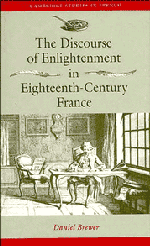Book contents
- Frontmatter
- Contents
- List of illustrations
- Acknowledgments
- Introduction
- 1 Representing knowledge: reading the Encyclopédie
- 2 Enlightenment critique and Diderot's art of philosophizing
- 3 The matter of judgment and the art of phrasing sensation
- 4 Critical narratives: Diderot's Salons
- 5 Embodying knowledge
- 6 Portraying Diderot: the aftermath
- 7 Interpreting Diderot: critical values, critical violence
- Notes
- Index
- Cambridge Studies in French
4 - Critical narratives: Diderot's Salons
Published online by Cambridge University Press: 23 November 2009
- Frontmatter
- Contents
- List of illustrations
- Acknowledgments
- Introduction
- 1 Representing knowledge: reading the Encyclopédie
- 2 Enlightenment critique and Diderot's art of philosophizing
- 3 The matter of judgment and the art of phrasing sensation
- 4 Critical narratives: Diderot's Salons
- 5 Embodying knowledge
- 6 Portraying Diderot: the aftermath
- 7 Interpreting Diderot: critical values, critical violence
- Notes
- Index
- Cambridge Studies in French
Summary
La sotte occupation que celle de nous empêcher sans cesse de prendre du plaisir, ou de nous faire rougir de celui que nous avons pris! C'est celle du critique.
DiderotIl faut apprendre à lire et à voir.
Diderot, Salon de 1767Begun in 1759 and spanning some twenty-two years, Diderot's reviews of the biennial exhibitions organized by the Royal Academy of Painting appeared during a time of marked transformation in the fine arts in France. As the principle of a classical, courtly style gradually lost its regulative force, painters enlarged the domain of the real that was judged presentable in art. The appeal of flamboyant rococo artifice steadily waned, displaced by the desire for scenes expressing classical high seriousness and exemplary morality. Around mid-century a mixed, hybrid style emerged, as artists experimented with ways to make visible new spaces and times, and to articulate esthetic and ethical values that would provide them with meaning.
Art historians have amply described the stylistic and thematic differences between eighteenth-century painting and that of the Grand Siècle. Description alone though cannot account for what causes these artistic experimentations, their purpose or their effects. If the descriptive idiom is monotonous, parasitic, and uncritical, as Diderot will realize, it is because description idealizes and essentializes the artwork, treating it as if its significance were immanent to form. Moreover, the formalism of descriptive discourse rests on the assumption that esthetic issues can be treated independently of supposedly nonesthetic ones, a decision that brackets, if not denies, whatever exists “outside” the work of art, located on “this side” of a supposedly essentially esthetic space.
- Type
- Chapter
- Information
- The Discourse of Enlightenment in Eighteenth-Century FranceDiderot and the Art of Philosophizing, pp. 132 - 167Publisher: Cambridge University PressPrint publication year: 1993



